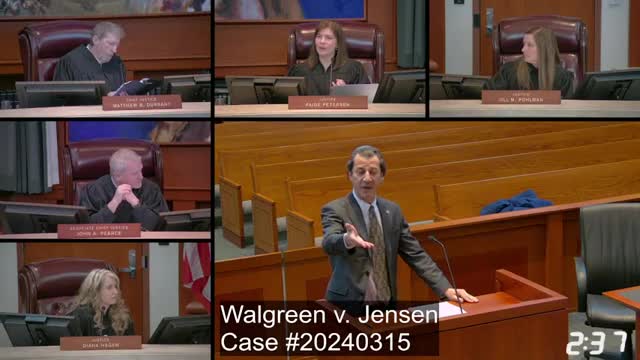Walgreens faces liability over fatal drug interaction in Utah case
March 15, 2024 | Utah Supreme Court, Utah Judicial Branch, Utah

This article was created by AI summarizing key points discussed. AI makes mistakes, so for full details and context, please refer to the video of the full meeting. Please report any errors so we can fix them. Report an error »

In a pivotal Utah Supreme Court oral argument on March 15, 2024, the case of Walgreen v. Jensen took center stage, spotlighting critical issues surrounding pharmacist liability and the interpretation of the learned intermediary doctrine. The case arose after the tragic death of Steven Jensen, who died following the dispensing of a prescription that was four times the FDA-recommended dosage.
During the proceedings, attorneys debated whether Walgreens acted negligently by overriding a warning about a potentially deadly drug interaction. The plaintiff's counsel argued that the pharmacist's decision to ignore the alert directly contributed to Jensen's death, asserting that Walgreens should be held accountable for failing to act as a reasonable pharmacist. "We think Judge Kelly properly recognized that the learned intermediary doctrine has a limited application in the context of negligence claims," the attorney stated, emphasizing the need for pharmacists to prioritize patient safety over procedural shortcuts.
The discussion also delved into the definition of "contraindicated" drugs, with justices seeking clarity on how this term applies in the context of pharmacy practice. The defense maintained that the drugs in question were not contraindicated as defined by the FDA, suggesting that the pharmacist's actions were justified under existing regulations. However, the plaintiff's side countered that the pharmacist's duty extends beyond merely filling prescriptions as written, especially when warnings are present.
As the court navigated these complex legal waters, the implications of their ruling could reshape the responsibilities of pharmacists in Utah. The outcome may set a precedent for how negligence is assessed in pharmacy practice, particularly regarding the balance between following physician prescriptions and ensuring patient safety. The justices are expected to deliberate further before issuing a decision that could have lasting effects on the pharmaceutical industry and patient care standards in the state.
During the proceedings, attorneys debated whether Walgreens acted negligently by overriding a warning about a potentially deadly drug interaction. The plaintiff's counsel argued that the pharmacist's decision to ignore the alert directly contributed to Jensen's death, asserting that Walgreens should be held accountable for failing to act as a reasonable pharmacist. "We think Judge Kelly properly recognized that the learned intermediary doctrine has a limited application in the context of negligence claims," the attorney stated, emphasizing the need for pharmacists to prioritize patient safety over procedural shortcuts.
The discussion also delved into the definition of "contraindicated" drugs, with justices seeking clarity on how this term applies in the context of pharmacy practice. The defense maintained that the drugs in question were not contraindicated as defined by the FDA, suggesting that the pharmacist's actions were justified under existing regulations. However, the plaintiff's side countered that the pharmacist's duty extends beyond merely filling prescriptions as written, especially when warnings are present.
As the court navigated these complex legal waters, the implications of their ruling could reshape the responsibilities of pharmacists in Utah. The outcome may set a precedent for how negligence is assessed in pharmacy practice, particularly regarding the balance between following physician prescriptions and ensuring patient safety. The justices are expected to deliberate further before issuing a decision that could have lasting effects on the pharmaceutical industry and patient care standards in the state.
View full meeting
This article is based on a recent meeting—watch the full video and explore the complete transcript for deeper insights into the discussion.
View full meeting

